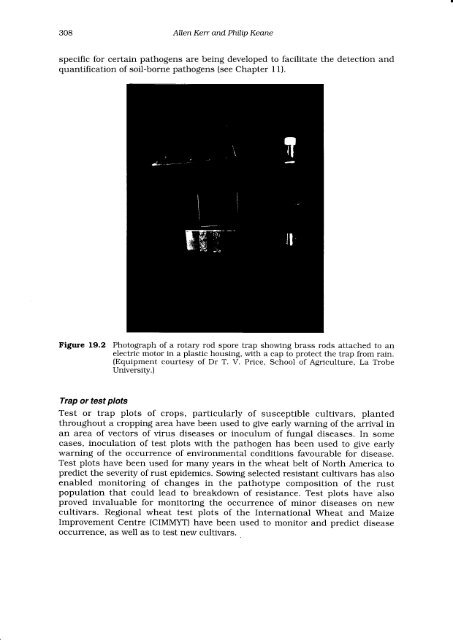PREDICTION OF DISEASE OUTBREAKS AIlen Kerr and Philip Keane
PREDICTION OF DISEASE OUTBREAKS AIlen Kerr and Philip Keane
PREDICTION OF DISEASE OUTBREAKS AIlen Kerr and Philip Keane
Create successful ePaper yourself
Turn your PDF publications into a flip-book with our unique Google optimized e-Paper software.
ALLen <strong>Kerr</strong> <strong>and</strong> <strong>Philip</strong> <strong>Keane</strong><br />
specific for certain pathogens are being developed to facilitate the detection <strong>and</strong><br />
quantification of soil-borne pathogens (see Chapter I1).<br />
Figure 19.2 Photograph of a rotary rod spore trap showing brass rods attached to an<br />
electric motor in a plastic housing, with a cap to protect the trap from rain.<br />
(Equipment courtesy of Dr T. V. Price, School of Agriculture, La Trobe<br />
Universitv.)<br />
Trap or test plots<br />
Test or trap plots of crops, particularly of susceptible cultivars, planted<br />
throughout a cropping area have been used to give early warning of the arrival in<br />
an area of vectors of virus diseases or inoculum of fungal diseases. In some<br />
cases, inoculation of test plots with the pathogen has been used to give early<br />
warning of the occurrence of environmental conditions favourable for disease.<br />
Test plots have been used for many years in the wheat belt of North America to<br />
predict the severity of rust epidemics. Sowing selected resistant cultivars has also<br />
enabled monitoring of changes in the pathotype composition of the rust<br />
population that could lead to breakdown of resistance. Test plots have also<br />
proved invaluable for monitoring the occurrence of minor diseases on new<br />
cultivars. Regional wheat test plots of the International Wheat <strong>and</strong> Maize<br />
Improvement Centre (CIMMYT) have been used to monitor <strong>and</strong> predict disease<br />
occurrence, as well as to test new cultivars.







![[Compatibility Mode].pdf](https://img.yumpu.com/27318716/1/190x135/compatibility-modepdf.jpg?quality=85)









